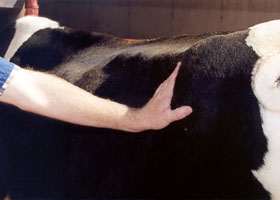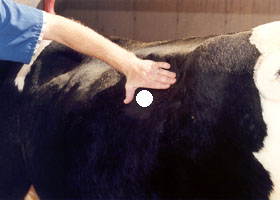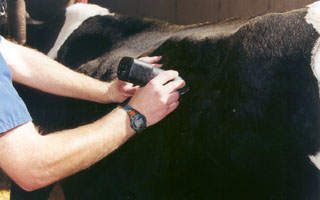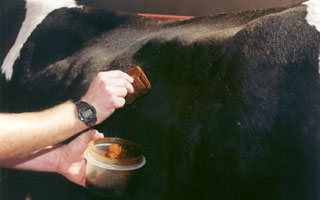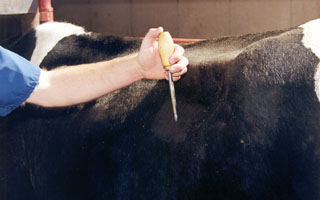Bloat is one of the
common problems encountered on a dairy operation. If treated properly and
aggressively, most cases have a favorable outcome. Many bloat conditions can be
prevented by using proper nutrition and sound management.
Clinical Signs:
- Distended abdomen, mostly on the left side, high in the flank area. (If
the animal is pregnant and seems to be distended on both sides of the
abdomen, special consideration should be given to a possible hydrops cow, or
late pregnancy. If these are a concern, consult a veterinarian.)
- The animal may have difficulty breathing, extend its neck and even make
grunting sounds.
- Signs of colic may also be present (kicking at abdomen, getting up and
down, etc.).
Causative Agents: There are two major categories of bloat:
- Free-gas/ Frothy bloat - This type of bloat can be brought on by
diets that cause excessive gas production in the rumen and decrease the
rumen pH. Diets high in grains, lush legumes, or winter wheat are causes
of this problem. This type of bloat can also be caused by poorly
digestible feed material and problems with indigestion (see page F350).
- Problems that are outside of the rumen - These include choke,
position of the animal, and hypocalcemia (milk fever).
Diagnosis: Most of the time this problem is not difficult to diagnose.
Many animals suffering from bloat can be identified just by appearance. The
difficulty arises when the exact cause for the bloat must be determined. To help
determine the exact cause of the bloat, the following procedures should be
performed on each animal:
- Pass a stomach tube into the rumen. See page B885
for suggestions on
passing a tube. This will relieve any gas and potentially any fluid. If gas
and/or fluid feed material come out of the tube, assume the animal has some
type of gas or frothy bloat problem. At this point, any fluid from the
stomach can be tested for pH level. If the pH level is lower than
approximately 5.5, the bloat may be caused by grain overload. For additional
information on pH testing, refer to page D620.
- If the tube does not pass easily, the animal could be choked and extreme
care should be used in passing the tube. If after a few gentle attempts of
passing the tube, the tube does not pass easily, consult a veterinarian.
- Listen to the rumen in the left flank area. This can identify if the bloat
is caused by indigestion. See "Additional Diagnostics" portion of
indigestion on page F350 and refer to page B880.
